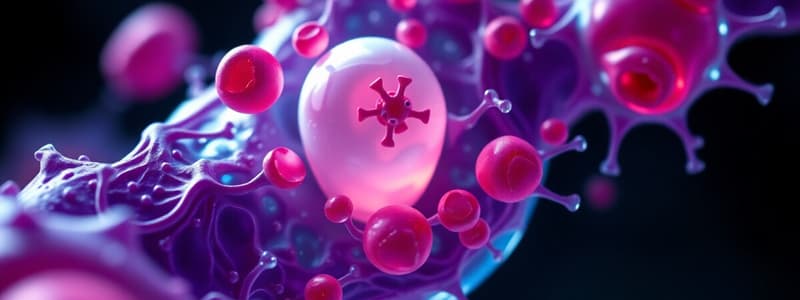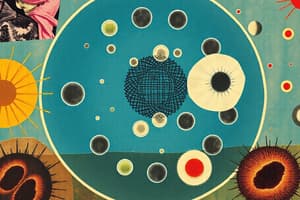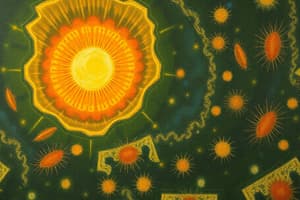Podcast
Questions and Answers
What is the primary function of the cytoplasm?
What is the primary function of the cytoplasm?
- Store genetic information
- Facilitate metabolic reactions (correct)
- Synthesize DNA
- Control cell division
Which component of the nucleus is responsible for the synthesis of ribosomal RNA?
Which component of the nucleus is responsible for the synthesis of ribosomal RNA?
- Nuclear Envelope
- Nucleolus (correct)
- Centrosome
- Chromatin
What are microtubules primarily composed of?
What are microtubules primarily composed of?
- Collagen
- Actin
- Myosin
- Tubulin (correct)
Which part of the cytoskeleton is involved in cell movement and shape?
Which part of the cytoskeleton is involved in cell movement and shape?
What structure is responsible for organizing microtubules during cell division?
What structure is responsible for organizing microtubules during cell division?
Which structure propels cells, such as sperm, through fluid?
Which structure propels cells, such as sperm, through fluid?
What is the role of the nuclear envelope?
What is the role of the nuclear envelope?
During cell division, chromatin condenses to form what structure?
During cell division, chromatin condenses to form what structure?
What is the primary function of ribosomes?
What is the primary function of ribosomes?
Which process is responsible for removing waste materials from the cell?
Which process is responsible for removing waste materials from the cell?
In which stage of mitosis do sister chromatids separate and move to opposite poles of the cell?
In which stage of mitosis do sister chromatids separate and move to opposite poles of the cell?
How does mitochondrial dysfunction affect cellular respiration?
How does mitochondrial dysfunction affect cellular respiration?
Why might the patient in the mitochondrial dysfunction case experience elevated lactic acid levels?
Why might the patient in the mitochondrial dysfunction case experience elevated lactic acid levels?
What is the role of cell cycle checkpoints in preventing cancer?
What is the role of cell cycle checkpoints in preventing cancer?
How might mutations in genes regulating the G1 phase contribute to tumor growth?
How might mutations in genes regulating the G1 phase contribute to tumor growth?
Which of the following best describes mitochondrial myopathy?
Which of the following best describes mitochondrial myopathy?
What is the primary function of microvilli in intestinal cells?
What is the primary function of microvilli in intestinal cells?
Where does the Krebs cycle occur within the cell?
Where does the Krebs cycle occur within the cell?
Which organelle is responsible for modifying, sorting, and packaging proteins?
Which organelle is responsible for modifying, sorting, and packaging proteins?
Which of the following processes produces ATP in the mitochondria?
Which of the following processes produces ATP in the mitochondria?
Which structure is involved in detoxification and lipid synthesis?
Which structure is involved in detoxification and lipid synthesis?
Which type of RNA is responsible for carrying amino acids to the ribosome?
Which type of RNA is responsible for carrying amino acids to the ribosome?
What is the role of lysosomes in the cell?
What is the role of lysosomes in the cell?
What serves as the final electron acceptor in the electron transport chain?
What serves as the final electron acceptor in the electron transport chain?
Which process involves the synthesis of mRNA from a DNA template?
Which process involves the synthesis of mRNA from a DNA template?
What is removed during mRNA processing?
What is removed during mRNA processing?
In which phase do sister chromatids separate?
In which phase do sister chromatids separate?
What is the primary outcome of meiosis?
What is the primary outcome of meiosis?
What is the main role of ribosomes in protein synthesis?
What is the main role of ribosomes in protein synthesis?
Which of the following phases occurs before mitosis?
Which of the following phases occurs before mitosis?
What is a characteristic feature of apoptosis?
What is a characteristic feature of apoptosis?
What type of cell division results in four genetically diverse cells?
What type of cell division results in four genetically diverse cells?
Flashcards
What is the cytoplasm?
What is the cytoplasm?
The gel-like substance within a cell, excluding the nucleus. It contains the cytosol, organelles, and various molecules. It serves as the site for many metabolic reactions and provides a medium for the organelles to remain suspended.
What is the nucleus?
What is the nucleus?
The control center of the cell, containing the cell's DNA. It is enclosed by a double membrane called the nuclear envelope, which contains nuclear pores allowing the exchange of materials between the nucleus and the cytoplasm.
What is the nuclear envelope?
What is the nuclear envelope?
A double lipid bilayer that encloses the nucleus, separating it from the cytoplasm. It contains nuclear pores allowing the exchange of materials between the nucleus and the cytoplasm.
What is the nucleolus?
What is the nucleolus?
Signup and view all the flashcards
What is chromatin?
What is chromatin?
Signup and view all the flashcards
What is the cytoskeleton?
What is the cytoskeleton?
Signup and view all the flashcards
What are microfilaments?
What are microfilaments?
Signup and view all the flashcards
What are microtubules?
What are microtubules?
Signup and view all the flashcards
What are microvilli?
What are microvilli?
Signup and view all the flashcards
What are ribosomes?
What are ribosomes?
Signup and view all the flashcards
What is the endoplasmic reticulum?
What is the endoplasmic reticulum?
Signup and view all the flashcards
What is rough ER?
What is rough ER?
Signup and view all the flashcards
What is smooth ER?
What is smooth ER?
Signup and view all the flashcards
What is the Golgi complex?
What is the Golgi complex?
Signup and view all the flashcards
What are lysosomes?
What are lysosomes?
Signup and view all the flashcards
What are mitochondria?
What are mitochondria?
Signup and view all the flashcards
What is transcription?
What is transcription?
Signup and view all the flashcards
What is translation?
What is translation?
Signup and view all the flashcards
What is the S phase?
What is the S phase?
Signup and view all the flashcards
What is mitosis?
What is mitosis?
Signup and view all the flashcards
What is apoptosis?
What is apoptosis?
Signup and view all the flashcards
What is meiosis?
What is meiosis?
Signup and view all the flashcards
What is uncontrolled cell proliferation?
What is uncontrolled cell proliferation?
Signup and view all the flashcards
What is interphase?
What is interphase?
Signup and view all the flashcards
What is the primary function of ribosomes?
What is the primary function of ribosomes?
Signup and view all the flashcards
What is the role of lysosomes in cellular function?
What is the role of lysosomes in cellular function?
Signup and view all the flashcards
When do sister chromatids separate during mitosis?
When do sister chromatids separate during mitosis?
Signup and view all the flashcards
How does mitochondrial dysfunction affect cellular respiration?
How does mitochondrial dysfunction affect cellular respiration?
Signup and view all the flashcards
Why might a patient with mitochondrial dysfunction have elevated lactic acid levels?
Why might a patient with mitochondrial dysfunction have elevated lactic acid levels?
Signup and view all the flashcards
What is the role of cell cycle checkpoints in preventing cancer?
What is the role of cell cycle checkpoints in preventing cancer?
Signup and view all the flashcards
How might mutations in genes regulating the G1 phase contribute to tumor growth?
How might mutations in genes regulating the G1 phase contribute to tumor growth?
Signup and view all the flashcards
What is the role of tumor suppressor genes and oncogenes in cell cycle regulation?
What is the role of tumor suppressor genes and oncogenes in cell cycle regulation?
Signup and view all the flashcards
Study Notes
Organelles and Cellular Processes
- Cells have essential organelles, crucial for function, replication, and response to the environment
- Organelles include cytoplasm, nucleus, cytoskeleton, endoplasmic reticulum, Golgi complex, lysosomes, and mitochondria
- These organelles facilitate key cellular processes: protein synthesis, DNA replication, and cell division
Cytoplasm
- Cytoplasm is the gel-like substance, excluding the nucleus
- Contains cytosol, organelles and various molecules
- Site of metabolic reactions
- Provides medium for organelle suspension
Nucleus
- Nucleus is the cell's control center, housing the cell's DNA
- Surrounded by a double membrane (nuclear envelope) with nuclear pores
- Pores allow material exchange between nucleus and cytoplasm
- Components include:
- Nuclear Envelope: double lipid bilayer separating nucleus from cytoplasm
- Nucleolus: dense region synthesizing ribosomal RNA (rRNA) and ribosome assembly
- Chromatin: DNA and proteins that condense into chromosomes during cell division
Cytoskeleton
- Provides structural support, enabling movement, and facilitating intracellular transport
- Components include microfilaments (actin), involved in cell movement, shape, and division
Microtubules
- Hollow tubes made of tubulin
- Maintain cell shape, allow intracellular transport, and are crucial during cell division (mitotic spindle)
Centrosome
- Organizes microtubules
- Contains centrioles, key in organizing the mitotic spindle
Cilia and Flagella
- Cilia: short, hair-like structures moving fluid or cells
- Flagella: long, whip-like structures propelling cells
Microvilli
- Finger-like extensions of plasma membrane
- Increase surface area (absorption, particularly in intestinal cells)
Ribosomes and Endoplasmic Reticulum
- Ribosomes: sites of protein synthesis (mRNA translation to polypeptides)
- Found free in cytoplasm or attached to endoplasmic reticulum (ER)
- Endoplasmic Reticulum (ER):
- Rough ER: studded with ribosomes, modifies/synthesizes proteins for plasma membrane, lysosomes, or secretion
- Smooth ER: lacks ribosomes, involved in lipid synthesis, detoxification, and calcium storage
Golgi Complex
- Modifies, sorts, and packages proteins and lipids received from the ER
- Transports them to different destinations within or outside the cell
Lysosomes and Mitochondria
- Lysosomes: membrane-bound organelles
- Contain digestive enzymes for waste material removal, cellular debris, foreign substances (cellular waste disposal and recycling)
- Mitochondria: powerhouse of the cell
- Produce ATP (adenosine triphosphate) through cellular respiration (glycolysis, Krebs cycle, electron transport chain)
Cellular Respiration
- Glycolysis: first stage, breaks down glucose in cytoplasm, producing ATP and NADH
- Krebs Cycle (citric acid cycle): occurs in mitochondria
- Oxidizes acetyl-CoA, produces ATP, NADH, FADH₂, and releases CO₂
- Electron transport chain: inner mitochondrial membrane
- Transfers electrons from NADH and FADH₂ to proteins, generating a proton gradient
- Drives ATP synthesis, oxygen serves as final electron acceptor (forming water)
DNA, RNA, and Protein Synthesis
- DNA (deoxyribonucleic acid): stores genetic information, guides protein synthesis and cell replication
- RNA (ribonucleic acid): transmits genetic information from DNA to ribosomes for protein synthesis
- mRNA (messenger RNA), tRNA (transfer RNA), rRNA (ribosomal RNA)
- Protein Synthesis:
- Transcription: mRNA synthesis from a DNA template in the nucleus.
- mRNA processing: splicing, 5' cap, poly-A tail additions
- Translation: ribosomes synthesize proteins by decoding mRNA
DNA Replication and Cell Division
- DNA replication during S phase (cell cycle) ensures identical copies for daughter cells
- Cell division:
- Somatic cell division (mitosis): single cell to two identical daughter cells
- Interphase: G1, S, G2 phases (cell growth, DNA synthesis, pre-division preparation)
- Mitosis: prophase, metaphase, anaphase, telophase
- Control of cell division regulated by checkpoints and signals
- Necrosis (uncontrolled cell death from injury) and Apoptosis (programmede cell death)
- Reproductive cell division (meiosis): half chromosome number in gametes (sperm/eggs)
- Somatic cell division (mitosis): single cell to two identical daughter cells
Multiple Choice Questions (MCQs)
- Mitochondria are responsible for ATP production
- DNA replication occurs in the S phase
Clinical Cases
- Mitochondrial dysfunction may lead to muscle weakness, fatigue, exercise intolerance, and elevated lactic acid levels
Studying That Suits You
Use AI to generate personalized quizzes and flashcards to suit your learning preferences.
Related Documents
Description
Explore essential organelles within cells, including the cytoplasm and nucleus. Understand their functions in protein synthesis, DNA replication, and cell division. This quiz covers the key processes and components vital for cellular operations.




